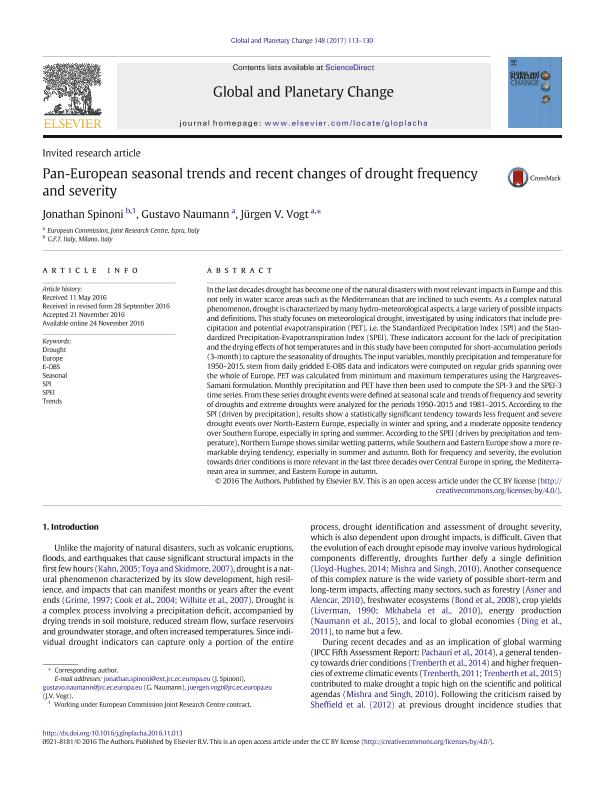Mostrar el registro sencillo del ítem
dc.contributor.author
Spinoni, Jonathan
dc.contributor.author
Naumann, Gustavo

dc.contributor.author
Vogt, Jürgen V.
dc.date.available
2018-09-14T17:34:23Z
dc.date.issued
2017-01
dc.identifier.citation
Spinoni, Jonathan; Naumann, Gustavo; Vogt, Jürgen V.; Pan-European seasonal trends and recent changes of drought frequency and severity; Elsevier Science; Global and Planetary Change; 148; 1-2017; 113-130
dc.identifier.issn
0921-8181
dc.identifier.uri
http://hdl.handle.net/11336/59701
dc.description.abstract
In the last decades drought has become one of the natural disasters with most relevant impacts in Europe and this not only in water scarce areas such as the Mediterranean that are inclined to such events. As a complex natural phenomenon, drought is characterized by many hydro-meteorological aspects, a large variety of possible impacts and definitions. This study focuses on meteorological drought, investigated by using indicators that include precipitation and potential evapotranspiration (PET), i.e. the Standardized Precipitation Index (SPI) and the Standardized Precipitation-Evapotranspiration Index (SPEI). These indicators account for the lack of precipitation and the drying effects of hot temperatures and in this study have been computed for short-accumulation periods (3-month) to capture the seasonality of droughts. The input variables, monthly precipitation and temperature for 1950–2015, stem from daily gridded E-OBS data and indicators were computed on regular grids spanning over the whole of Europe. PET was calculated from minimum and maximum temperatures using the Hargreaves-Samani formulation. Monthly precipitation and PET have then been used to compute the SPI-3 and the SPEI-3 time series. From these series drought events were defined at seasonal scale and trends of frequency and severity of droughts and extreme droughts were analyzed for the periods 1950–2015 and 1981–2015. According to the SPI (driven by precipitation), results show a statistically significant tendency towards less frequent and severe drought events over North-Eastern Europe, especially in winter and spring, and a moderate opposite tendency over Southern Europe, especially in spring and summer. According to the SPEI (driven by precipitation and temperature), Northern Europe shows similar wetting patterns, while Southern and Eastern Europe show a more remarkable drying tendency, especially in summer and autumn. Both for frequency and severity, the evolution towards drier conditions is more relevant in the last three decades over Central Europe in spring, the Mediterranean area in summer, and Eastern Europe in autumn.
dc.format
application/pdf
dc.language.iso
eng
dc.publisher
Elsevier Science

dc.rights
info:eu-repo/semantics/openAccess
dc.rights.uri
https://creativecommons.org/licenses/by-nc-nd/2.5/ar/
dc.subject
Drought
dc.subject
E-Obs
dc.subject
Europe
dc.subject
Seasonal
dc.subject
Spei
dc.subject
Spi
dc.subject
Trends
dc.subject.classification
Meteorología y Ciencias Atmosféricas

dc.subject.classification
Ciencias de la Tierra y relacionadas con el Medio Ambiente

dc.subject.classification
CIENCIAS NATURALES Y EXACTAS

dc.title
Pan-European seasonal trends and recent changes of drought frequency and severity
dc.type
info:eu-repo/semantics/article
dc.type
info:ar-repo/semantics/artículo
dc.type
info:eu-repo/semantics/publishedVersion
dc.date.updated
2018-09-14T13:16:30Z
dc.journal.volume
148
dc.journal.pagination
113-130
dc.journal.pais
Países Bajos

dc.journal.ciudad
Amsterdam
dc.description.fil
Fil: Spinoni, Jonathan. GFT Italy; Italia
dc.description.fil
Fil: Naumann, Gustavo. European Commission. Joint Research Centre; Italia. Consejo Nacional de Investigaciones Científicas y Técnicas; Argentina
dc.description.fil
Fil: Vogt, Jürgen V.. European Commission. Joint Research Centre; Italia
dc.journal.title
Global and Planetary Change

dc.relation.alternativeid
info:eu-repo/semantics/altIdentifier/doi/http://dx.doi.org/10.1016/j.gloplacha.2016.11.013
dc.relation.alternativeid
info:eu-repo/semantics/altIdentifier/url/https://www.sciencedirect.com/science/article/pii/S0921818116301801
Archivos asociados
